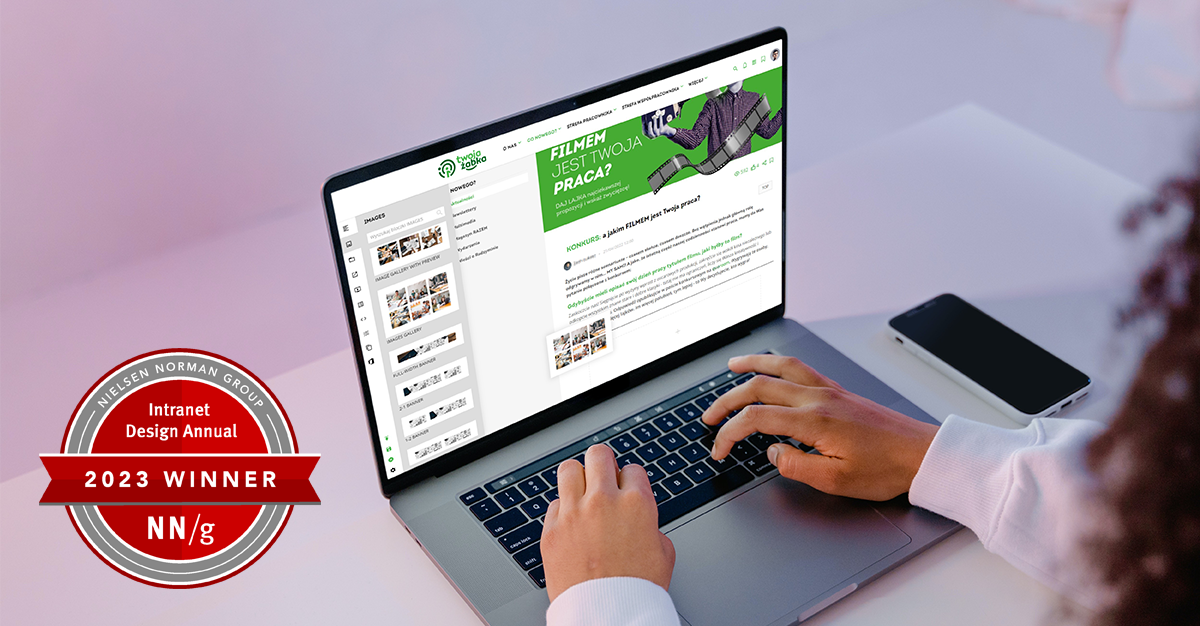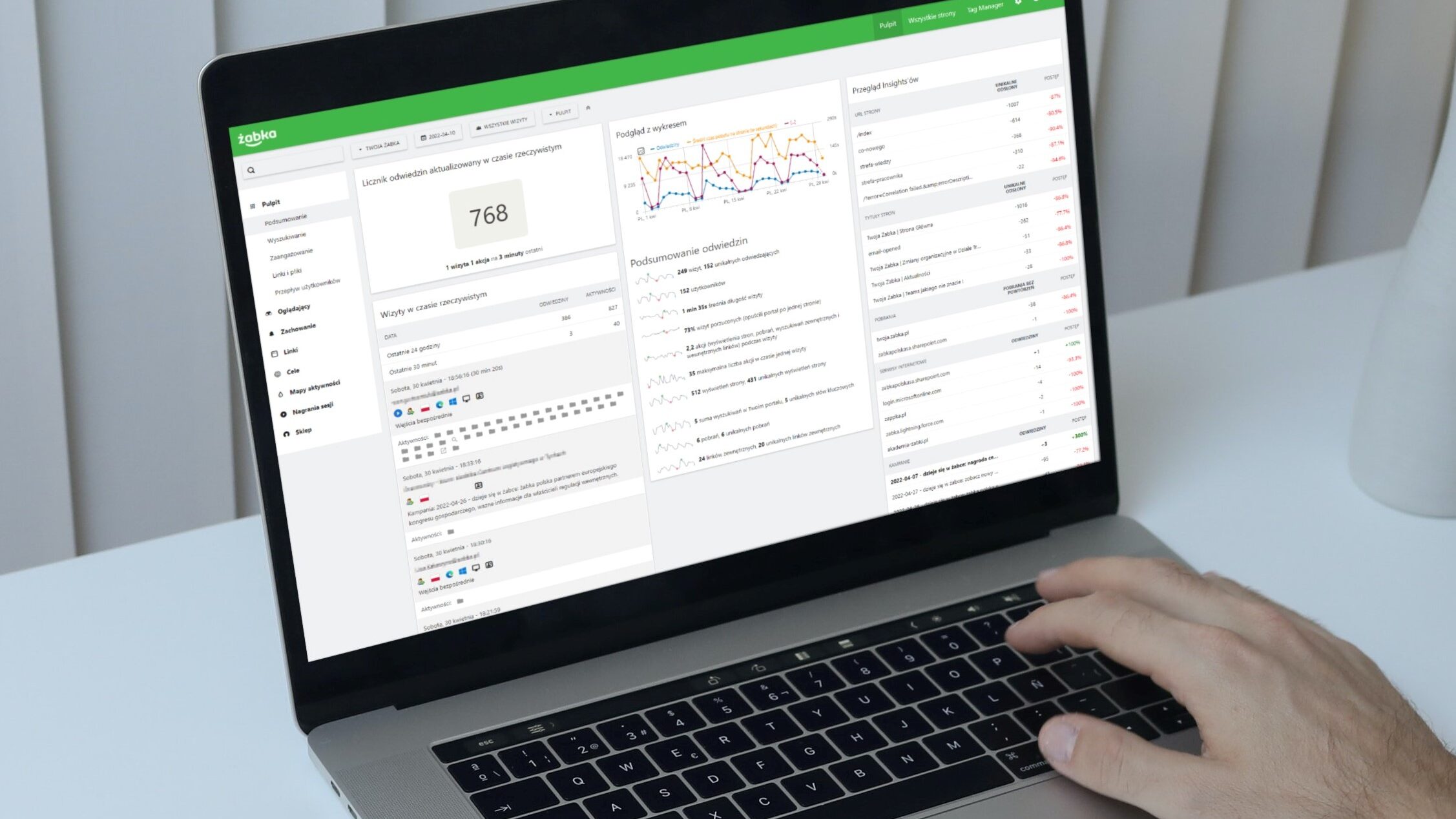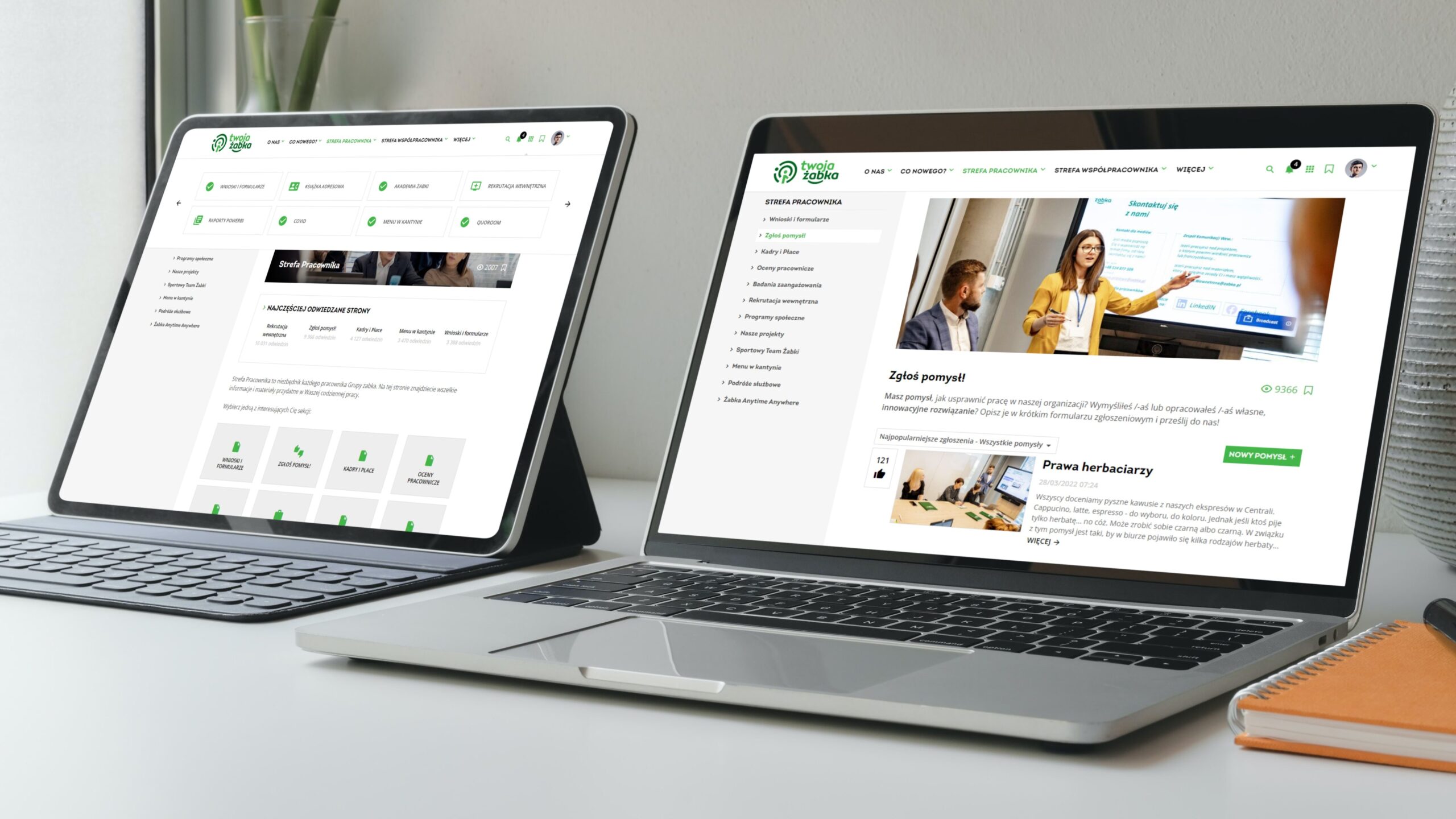

TOP 10 intranet deployment best practices
Implementing an intranet within an organization can be a daunting task, riddled with challenges that often lead to long-running projects, low adoption rates, and skyrocketing costs.
The path to a successful intranet deployment is fraught with pitfalls that can derail even the most well-intentioned efforts. However, armed with a comprehensive understanding of the struggles that often accompany intranet deployment, and guided by our battle-tested best practices, organizations can not only overcome these obstacles but also transform their workplace communication and collaboration.
Drawing inspiration from real-world experiences, including the remarkable journey of our NN/g winning intranet deployment at Żabka Polska, we present the top 10 intranet deployment best practices that navigate the treacherous waters of the process.
For your convenience, each best practice contains sections with Benefits, Examples, and Action points.
1. Clearly Define and Align Objectives of the intranet deployment
Defining clear and achievable objectives is crucial when implementing a new intranet. Why is it so? Without well-defined goals, the project can lack direction, and measuring success becomes challenging.
To start, set clear objectives that align with your organization’s needs—improving communication, document management, or collaboration. Evaluate current processes, identify gaps, and focus on improving the employee experience and company relations. Foster communication through various channels, personalize content and ensure strong search capabilities. Consider off-the-shelf solutions for technical efficiency, adaptability, and content personalization. Remember, comprehensive analytics, diverse media integration, and continuous improvement planning enhance employee engagement.

▶️BENEFITS: Setting clear objectives guides the entire intranet deployment process and ensures a focused approach. It also provides a benchmark for measuring success and impact.
▶️EXAMPLE: Żabka Polska’s objectives included enhancing communication, streamlining document access, and fostering collaboration. This led to choosing an intranet solution that directly addressed their needs.
▶️ACTION POINTS:
- Evaluate existing processes and identify gaps in communication, document management, and collaboration.
- Align objectives with organizational needs and prioritize employee experience and company relations.
- Foster communication through diverse channels and personalize content for relevance.
- Implement robust search capabilities to enhance information discovery.
- Explore off-the-shelf solutions that offer technical efficiency, adaptability, and content personalization.
- Leverage comprehensive analytics and integrate diverse media for an engaging user experience.
- Plan for continuous improvement to ensure ongoing alignment with evolving needs.
2. Involve Stakeholders from the Start of the intranet deployment process
To ensure informed decision-making and a successful intranet deployment, engage stakeholders from various departments during the planning process. Their insights shape functionalities to meet diverse employee needs. This involvement is crucial for several reasons:
- Holistic Understanding: Stakeholders provide a comprehensive view of needs and goals, leading to informed solutions.
- Prioritized Features: Insights from different departments help prioritize features and processes that might be overlooked.
- Ownership and Commitment: Involvement fosters ownership and support, enhancing project success.
- Alignment with Goals: Stakeholders ensure alignment with business objectives, reducing misalignment risks.
- Early Issue Identification: Unique insights identify potential challenges and roadblocks early.
- Adoption Boost: Stakeholder input increases solution acceptance and adoption.
- Effective Change Management: Early engagement eases resistance and communicates benefits.
- Risk Reduction: Diverse viewpoints identify and mitigate potential risks.
- Innovation: Collaboration encourages creative problem-solving and innovative ideas.
- Efficient Decision-Making: Involving stakeholders streamlines solution-focused decision-making.
Incorporating various tools into a coherent employee experience platform required collaboration between technical and business stakeholders, ensuring the platform catered to diverse needs. This approach resulted in an intranet that met stakeholder requirements and allowed iterative improvements based on user feedback and evolving needs.
▶️BENEFITS: Early stakeholder engagement ensures a comprehensive understanding of needs, facilitates prioritization, reduces risks, and fosters ownership, resulting in a more successful intranet deployment.
▶️EXAMPLE: Żabka Polska’s inclusive approach involved stakeholders from multiple departments by conducting a thorough audit of existing content and systems. Engaging relevant departments in workshops refined the intranet’s information architecture, resulting in tailored solutions that met requirements and facilitated iterative improvements based on user feedback.

▶️ACTION POINTS:
- Include stakeholders from various departments to ensure diverse perspectives.
- Leverage their insights to shape functionalities that meet specific employee needs.
- Prioritize features that might otherwise be overlooked.
- Foster a sense of ownership and commitment among stakeholders.
- Align with business goals to minimize misalignment risks.
- Identify potential challenges and roadblocks through unique insights.
- Boost solution acceptance and adoption through stakeholder input.
- Use early engagement to ease resistance to change and communicate benefits.
- Mitigate potential risks by considering diverse viewpoints.
- Encourage collaboration for creative problem-solving and innovation.
3. Select the Right Intranet Platform
The marketplace is awash with intranet solutions, but selecting the right one can be a daunting task. The wrong platform can lead to spiraling costs and functionality mismatches. By meticulously analyzing needs and opting for a customizable and user-friendly solution like Workai’s, it’s possible to sidestep these pitfalls.
Has your company decided to implement a ready-made intranet solution? How then, among the available solutions, to choose the best one?
▶️BENEFITS: Choosing the right intranet platform ensures seamless implementation, enhanced user experience, and effective communication and collaboration tools.
▶️EXAMPLE: Żabka Polska’s successful implementation was aided by their careful selection of the Workai platform, which aligned with key objectives. This choice enabled streamlined content migration, enhancing the user experience and personalizing communication. The platform’s adaptability and integration capabilities created a unified environment that addressed the company’s specific requirements effectively.
▶️ACTION POINTS:
- Conduct a thorough needs analysis to understand organization and employee requirements.
- Seek a multifunctional platform with communication, collaboration, and content management features.
- Explore platforms that align with your organization’s needs and goals.
- Consider the platform’s adaptability and integration capabilities.
- Evaluate how well the platform’s features match your communication and collaboration requirements.
- Look for solutions that offer technical support and responsive interfaces.
- Prioritize platforms that allow customization to reflect company preferences and user expectations.
- Assess the platform’s ability to integrate with existing tools for seamless workflows.
- Choose a platform that can cater to remote work needs and device responsiveness.

4. Tailor Content for User Needs
Effective intranet usage requires a balance between content customization and avoiding overload. While personalization enhances the experience, excessive customization can overwhelm users, causing them to miss crucial information.
To address this, adopt a user-centric approach to content organization on your intranet platform. Rather than overwhelming users, provide tools for customizing their content feed based on preferences. This might include subscribing to specific topics, departments, or projects to ensure users receive relevant updates.
Intelligent content recommendations based on user behavior can further align content with preferences. Robust search features and categorized content enhance the user experience. Regularly collect user feedback and analyze engagement patterns for ongoing refinement. By combining user input with data-driven insights, you can maintain the right balance, ensuring the intranet remains a valuable asset for all employees while considering internal SEO best practices.
▶️BENEFITS: Tailoring content ensures that employees receive relevant information, enhancing engagement and productivity.
▶️EXAMPLE: Żabka Polska’s intranet success was influenced by their approach to content personalization. By adopting user-centric segmentation and filtering, they enabled employees to receive information aligned with their preferences. This approach enhanced user experience and engagement, contributing to the intranet’s effectiveness.
▶️ACTION POINTS:
- Balance content customization and avoid overwhelming users.
- Implement user-centric segmentation and filtering.
- Provide tools for users to customize their content feed based on preferences.
- Enable subscription to specific topics, departments, or projects for relevant updates.
- Utilize intelligent content recommendations based on user behavior.
- Enhance user experience with robust search features and categorized content.
- Collect user feedback and analyze engagement patterns for continuous improvement.
- Combine user input with data-driven insights to maintain a valuable intranet.
5. Provide comprehensive training
Comprehensive training plays a pivotal role in ensuring the successful adoption of the new intranet across the organization. By offering tailored workshops and valuable resources, companies can empower employees to make the most of the platform’s capabilities with confidence and ease.
Workshops: Hosting workshops dedicated to the intranet’s features and functionalities allows employees to gain hands-on experience. These sessions can cover topics such as navigation, content creation, communication tools, and collaboration features. Workshops can be conducted in person or virtually, catering to diverse learning preferences and remote work arrangements.
User Guides and Resources: Alongside workshops, providing comprehensive user guides, tutorials, and video demonstrations further enhances the learning process. These resources should be easily accessible and organized to cater to different skill levels. Clear instructions and visual aids help employees navigate the platform smoothly and independently.

Interactive Learning: Interactive training modules, quizzes, and simulations can engage employees in a dynamic learning experience. This approach not only reinforces understanding but also encourages active participation and knowledge retention.
Continuous Support: Training shouldn’t be a one-time event. Establish ongoing support channels, such as dedicated help desks, FAQs, and online forums, where employees can seek assistance and share insights. This fosters a culture of continuous learning and ensures that employees feel supported as they explore and utilize the intranet.
▶️BENEFITS: By investing in comprehensive training, organizations empower employees to embrace the new intranet confidently, enhancing its impact on communication, collaboration, and overall productivity.
▶️EXAMPLE: Żabka Polska’s intranet success can be attributed to its comprehensive training approach. They conducted workshops covering various aspects of the intranet, offered user guides, and incorporated interactive learning methods, ensuring employees were confident in utilizing the platform’s capabilities.
▶️ACTION POINTS:
- Conduct workshops focusing on intranet features and functionalities.
- Cover topics like navigation, content creation, communication tools, and collaboration features.
- Offer workshops both in person and virtually to accommodate different learning preferences.
- Provide comprehensive user guides, tutorials, and video demonstrations.
- Organize resources to cater to different skill levels and learning styles.
- Use clear instructions and visual aids to aid navigation and independent use.
- Incorporate interactive training modules, quizzes, and simulations for dynamic learning.
- Establish continuous support channels like help desks, FAQs, and communities.
- Foster a culture of continuous learning and support for intranet use.
6. Encourage Employee Participation in the intranet deployment process
Low engagement on the intranet is a challenge due to motivation issues and time constraints. To overcome this, consider gamification and recognition strategies. Gamification adds elements like badges and leaderboards to create competition and motivation. Recognize contributions with public appreciation, certificates, or incentives. Leadership involvement and clear engagement guidelines encourage participation. Sharing success stories showcases the benefits of engagement, motivating employees further. By combining gamification, recognition, and leadership involvement, organizations can foster a culture of active intranet participation.
▶️BENEFITS: Encouraging employee participation through gamification and recognition boosts engagement and creates a culture of active intranet usage.
▶️EXAMPLE: Żabka Polska’s intranet engagement was elevated by implementing gamification and recognition elements. They introduced badges, leaderboards, and public appreciation for contributions, motivating employees to actively engage with the platform.
▶️ACTION POINTS:
- Implement gamification elements like badges, leaderboards, and points.
- Create healthy competition among employees to motivate participation.
- Recognize contributions through public appreciation, certificates, or incentives.
- Involve leadership in encouraging and recognizing employee engagement.
- Establish clear guidelines for employee engagement and participation.
- Share success stories showcasing the positive outcomes of engagement.
- Highlight how active participation enhances the intranet’s benefits.
- Combine gamification, recognition, and leadership involvement for maximum impact.
- Foster a culture where employees feel motivated to actively use the intranet.
7. Ensure Mobile Accessibility
In the age of mobility, employees expect universal access to information. When building a new intranet, prioritize mobile responsiveness for inclusivity. Front-line employees, often without computer access, require quick intranet entry.
For mobile accessibility, ensure a seamless cross-device experience. Without mobile optimization, navigation, access, and engagement become challenging, leading to frustration and lower adoption rates.
The solution involves Responsive Design and an Employee App. The intranet should adapt to diverse screens, offering user-friendly interactions on phones and tablets. Touch-friendly navigation and streamlined interfaces enhance mobile usage.

Consider a dedicated mobile app for tailored functions: push notifications, offline access, and simplified navigation. A well-crafted app ensures effortless access to info and features from any location.
Test on various devices and gather user feedback for refining mobile usability. This iterative process maintains user-friendliness, aligning with modern workforce expectations.
▶️BENEFITS: Mobile accessibility ensures information is accessible to all employees, including front-line workers, enhancing agility and inclusivity.
▶️EXAMPLE: Recognizing the importance of mobile access, Żabka Polska ensured their workforce had access to the Employee App connected to the intranet. This move empowered front-line employees who lacked computer access, enabling them to stay connected and informed. The app features centralized search, push notifications, and offline access, ensuring that information and features are accessible to employees no matter where they are.
▶️ACTION POINTS:
- Recognize the significance of mobile access for all employees.
- Ensure a seamless experience across various devices.
- Optimize the intranet for mobile devices to enhance usability.
- Responsive design enables a user-friendly experience on phones, tablets, etc.
- Streamline navigation for touch-friendly interactions.
- Consider developing a dedicated mobile app for tailored functions.
- Provide features like push notifications and offline access in the app.
- Simplified navigation ensures easy access to information.
- Test on multiple devices to address mobile usability challenges.
- Gather user feedback to continually improve the mobile experience.
8. Monitor Analytics and Gather Feedback
Regularly track behavior and gather feedback to enhance the intranet and align with goals. Challenges can arise from incomplete analysis and misalignment. A data-driven approach is the solution: use robust analytics tools for insights on user behavior, engagement, and content use.
Regularly review analytics, identify trends, and foster a continuous feedback loop. Encourage user input through surveys, forms, and forums for valuable insights. Merge data-driven insights with direct feedback to optimize the intranet’s alignment with goals and user needs.
This iterative process ensures the intranet’s evolution to meet user needs and company objectives.
▶️BENEFITS: Regularly tracking user behavior and gathering feedback helps organizations make informed improvements, enhancing intranet performance and alignment with strategic goals.

▶️EXAMPLE: Żabka Polska’s intranet deployment incorporated robust analytics tools to track user behavior and engagement. This enabled them to identify popular areas, features, and user challenges, allowing them to continuously optimize the intranet’s effectiveness.
▶️ACTION POINTS:
- Emphasize the importance of data-driven insights for refinement.
- Use analytics tools to track user behavior, content consumption, and engagement.
- Identify areas of the intranet most utilized by employees.
- Recognize popular features and functionalities.
- Analyze user behavior to uncover potential challenges.
- Regularly review analytics to identify trends and opportunities for improvement.
- Establish a continuous feedback loop to gather user suggestions.
- Provide accessible channels for user feedback, such as surveys and discussion forums.
- Encourage users to actively share their experiences and insights.
9. Regularly Update and Improve
Challenges in analytics and feedback can hinder understanding of user engagement and effectiveness, leading to missed improvements.
Overcome this with a data-driven approach and a solution with a roadmap aligned with Employee Experience. Use robust analytics tools for insights on user behavior, engagement, and content use.
Create a feedback loop through easy channels like surveys and forums to foster ownership and identify pain points.
Merge data insights and direct feedback to refine the intranet, ensuring alignment with goals. This iterative process adapts the intranet to evolving user needs and company strategies.
▶️BENEFITS: Regularly updating and improving the intranet based on user feedback and data-driven insights enhances its performance and alignment with organizational objectives.
▶️EXAMPLE: Żabka Polska’s intranet deployment showcased the value of continuous improvement. By consistently monitoring user behavior and gathering feedback, they were able to identify areas for enhancement and align their solutions with evolving user needs and company goals. Furthermore, Workai platform updates ensure that the solution is constantly improving and internal communications team can use new solutions to engage and communicate with the entire organization.
▶️ACTION POINTS:
- Choose an intranet solution that has a long roadmap of features
- Emphasize the importance of regular updates for intranet success.
- Address challenges related to incomplete analysis and goal misalignment.
- Advocate for a data-driven approach using robust analytics tools.
- Track user behavior, engagement, and content usage patterns.
- Identify high-demand areas, user pain points, and emerging trends.
- Utilize data insights to guide optimization efforts.
- Implement a continuous feedback loop to encourage user input.
- Offer easily accessible feedback channels like surveys and forums.
- Cultivate a sense of user ownership through interactive communication.
10. Celebrate Success and Recognize Achievements
Acknowledge intranet deployment success, celebrate milestones, and boost morale through recognition. However, oversight in acknowledging efforts during deployment can lower morale, hindering engagement.
Address this by fostering an appreciation culture. Communicate deployment progress transparently, involving all employees in milestones. Recognize and celebrate pivotal individuals and teams. This can include public acknowledgments, awards, or thank-you messages. Showcase positive impacts on communication, collaboration, and work experience.

Incorporate success stories from benefited employees for tangible examples. This fosters community engagement. Consistently celebrating achievements and recognizing contributions cultivates a positive atmosphere, boosting morale, and reinforcing the intranet’s value.
▶️BENEFITS: Celebrating the successful deployment of the intranet and recognizing employee contributions fosters a positive work environment, boosts morale, and encourages ongoing engagement with the platform.
▶️EXAMPLE: The intranet deployment at Żabka Polska illustrates the significance of celebrating achievements. By acknowledging milestones and appreciating the efforts of individuals and teams, they were able to foster a sense of accomplishment and commitment among employees.
▶️ACTION POINTS:
- Emphasize the importance of acknowledging successes for employee morale.
- Address the challenge of potential oversight in recognizing deployment efforts.
- Promote the creation of an appreciative and recognition-oriented culture.
- Regularly communicate progress and milestones to involve all employees.
- Highlight the positive impact of the intranet on communication and collaboration.
- Recognize individuals and teams for their contributions through various means.
- Employ public acknowledgments, awards, or thank-you messages.
- Incorporate success stories and testimonials from benefited employees.
- Showcase tangible examples of improved work processes and outcomes.
- Foster a sense of community engagement and shared accomplishments.
The best intranet deployment in the world at Żabka Polska
Żabka Polska, a leading retail company, successfully implemented its intranet platform following the top 10 best practices outlined above. With a clear vision of their objectives, they engaged employees from various departments to gather valuable insights. After evaluating multiple intranet platforms, they selected Workai’s solution for its robust features and user-friendly interface.
Żabka Polska customized the intranet’s content to cater to their employees’ specific needs, ensuring information was relevant and easily accessible. Comprehensive training sessions were conducted to familiarize employees with the new platform, resulting in seamless user adoption.
The company encouraged employee participation through interactive features, fostering a collaborative work environment. The intranet was optimized for mobile access, enabling employees to stay connected even while on the move.
Żabka Polska consistently monitored intranet analytics and gathered feedback from employees to make continuous improvements. Regular updates were implemented, reflecting the company’s commitment to staying at the forefront of intranet technology.
Through successful implementation and ongoing dedication to improvement, Żabka Polska’s intranet has become an indispensable tool for internal communication and collaboration, contributing to enhanced productivity and engagement, and winning employees’ love and involvement.
Conclusion
The struggles of intranet deployment are real, but they need not be insurmountable. By acknowledging the potential risks and challenges, and embracing the proven best practices outlined above, organizations can transform their intranet deployment journey from a perilous expedition into a triumph of communication, collaboration, and employee engagement.
As demonstrated by Żabka Polska, a well-executed intranet can elevate internal communication and collaboration, ultimately contributing to overall business success, and winning some global awards during the process 😊
